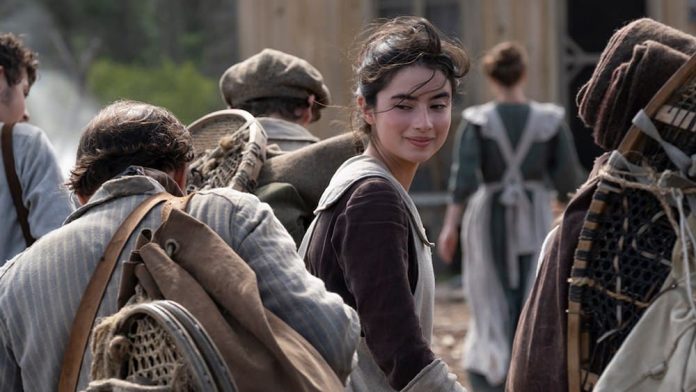Artnewspress :
This latest adaptation of Louis Hemon’s Quebec-lit classic is handsome but a bit too reverent and poky.
Among authors who didn’t live to witness their own success, Louis Hemon is a particularly unfortunate case — his novel “Maria Chapdelaine” was published in 1913, the same year as his train-struck death. Thus he didn’t see it become an early Quebec-lit classic taught to generations of schoolchildren, published in translation worldwide or adapted into many other media over the past century. Among prior screen versions were two made in his native France, the 1934 one notable as Julien Duvivier’s first collaboration with Jean Gabin.
The slim book, drawing on adventure-seeking Hemon’s own experiences briefly working as a farmhand in the Lac Saint-Jean region, has been treated with less-than-strict fidelity by previous dramatists. Sebastien Pilote’s new film is probably the most faithful to date by far — though that isn’t entirely a plus. Handsome and leisurely, this low-key portrait of isolated rural family life 110 years ago is a labor of love lacking an equal dose of inspiration. It’s a well-produced episodic tale whose incidents and personalities remain too modest to sustain nearly three hours’ illustration, given a lack of narrative momentum and one major casting shortfall.
The source material’s cultural significance and a talented director’s rising rep will place it among the year’s more significant releases within Canada, But this “Maria Chapdelaine” lacks the spark that might’ve given it wings as an attractive art-house or quality-television item abroad.
We first meet the titular teenage Maria (newcomer Sara Montpetit) attending Mass in town before traveling back home with her father, Samuel (Sebastien Ricard), via horse and sleigh — the last time they’ll be able to cross the Peribonka River thus before it freezes over again next winter. It’s also the last time we’ll glimpse “civilization” for the next 90 minutes, as the Chapdelaines live on a remote homestead that’s near inaccessible much of the year. This isolation is a burden to matriarch Laura (Helene Florent), whose husband has steadily moved them further and further from society. With six children to care for, plus farm labor, she’s hardly idle. But the absence of a community has been hard for her, as has the family’s ongoing subsistence struggle — the eldest sons already work seasonal logging jobs to help support all.
Unbeknownst to her kin, Maria has run across a longtime acquaintance in town: Francois Paradis (Emile Schneider), who on occasion returns to the area of his upbringing but prefers a trapper’s transient life, hunting and trading with Native peoples. Despite Francois’ infrequent appearances, something is brewing between him and Maria, who’s now of marriageable age. Then again, there’s the closer-to-home, more reliable future dangled by the Chapdelaines’ sole neighbor, young bachelor farmer Eutrope Gagnon (Antoine Olivier Pilon). Eventually Maria has a third suitor in the form of visiting stranger Lorenzo Suprenant (Robert Naylor). He was also raised hereabouts but now lives in the almost unimaginably cosmopolitan environ of a midsize Massachusetts city, where he works in a factory.
These shy courtships provide the principal narrative suspense here, such as it is. Otherwise, “Maria Chapdelaine” is mostly about the constant labor and familial togetherness of this secluded existence, which Pilote etches in painstaking but pleasurable detail. The great natural beauty of the landscape in DP Michel La Veaux’s imagery doesn’t obscure the difficulty of these lives, even if the characters take their toiling lot for granted. A lethal blizzard and a later, second death may be tragic, but they’re also simply part and parcel of carving out an existence in such challenging wilderness.
As in Jan Troell’s “The Emigrants” and its sequel half a century ago, there is considerable reward in the filmmakers’ scrupulous attention (and that of production designer Jean Babin) to the details of settler self-sufficiency. But those movies had great actors absorbing us into the inner lives of “simple,” inarticulate yet compelling characters. It is a measure of “Maria Chapdelaine’s” relative failure on that score that when death strikes here, what should have terrible poignancy somehow carries little emotional force.
You can’t blame Ricard or (particularly) Florent, who bring considerable depth to parents who love one another while realizing they might have been happier with another spousal choice. There also are a few brightening support turns, notably from Martin Dubreuil as the family’s seasonal hired hand. But the Chapdelaine children aren’t lent much individuality, and even the suitors fail to make memorable impressions, with Pilon faring best on the strength of sheer charm.
An undeniable problem is the most-central casting: Making her screen debut, stage-trained Montpetit doesn’t have to carry the film by herself, but she cannot shoulder her share. Much closer to the character’s intended age than prior interpreters (Madeleine Renaud, Michele Morgan and Carole Laure were all in their 30s), she captures the character’s dutiful placidity — so different from the “free spirit” entertaining another suitor trio in “Far From the Madding Crowd.” There is, however, nothing tangible underneath. She hasn’t yet the technique or magnetism to suggest roiling emotions, too often seeming blank when we ought to perceive a deep well of unspoken thoughts. The result isn’t quite so glaring an error as Sofia Coppola’s appearance in “The Godfather: Part III.” Still, it’s an inexpressive turn that creates a gap where the film ought to find its empathetic core of strength.
That key flaw underlines the lack of urgency and involvement that makes this long yet decidedly non-epic story feel at once pleasant and undernourished — far less rich than the yea more loosely plotted gold standard for Quebec rural stories on film, Claude Jutra’s 1971 “Mon Oncle Antoine.” Perhaps overcome by reverence for the source material, Pilote hasn’t infused it with the same degree of vivid life he brought to his own small-town studies “The Salesman” and “The Fireflies Are Gone.” Nonetheless, his adaptation is graceful and rewarding within its limits, the thoughtful design elements encompassed by an attractive chamber string score by Philippe Brault.
























